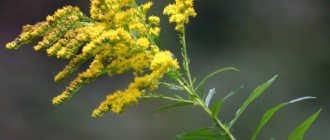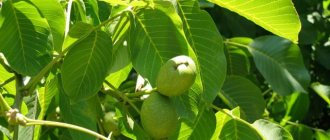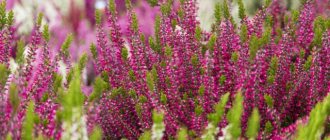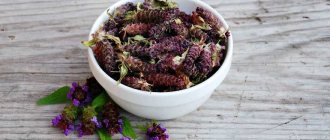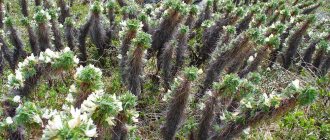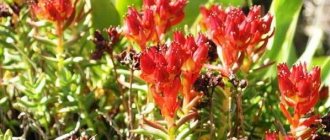Healing properties of birch
And the healing properties of this tree are countless. Every part of it has value.
Birch buds
Birch buds are very useful; they are collected in the spring during swelling. If desired, you can harvest them in winter. To do this, branches are cut from the tree, tied in bunches and stored in a cool place until they swell. The buds are then separated and dried.
Decoctions or infusions of dried buds help with various diseases of the heart and liver. A decoction of birch buds is used as a diuretic. To enhance the effect, add a pinch of baking soda to the broth.
Compresses are made from an alcohol tincture of birch buds for rheumatism, ulcers, chronic purulent wounds, and abrasions.
Young leaves
Young fragrant leaves begin to be collected in the spring; at this time they are sticky and release a lot of phytoncides. The leaves are weaker than the buds.
What are the benefits of birch leaves:
- a decoction or infusion of dried leaves is taken to regulate menstruation;
- Young leaves are used to make tea and drink for vitamin deficiency. This drink contains a lot of vitamin C. To improve the taste, you can add citric acid to it;
- An infusion of birch leaves is useful for giardiasis.
In the North, young leaves were harvested to treat colds. They covered sore joints with steamed leaves. The top was wrapped with woolen cloth.
Birch leaves are used to wash your hair so that your hair grows well.
Birch tar
My childhood memories are largely connected with tar. Father rubbed his tarpaulin boots with it, giving them shine. Grandmother lubricated our sores with this “smelly” ointment. Birch tar is a dark oily liquid with a specific odor. Sold mainly in pharmacies. It is the main ingredient of the famous Vishnevsky ointment, and is also part of anthrasulfone and tar ointments. You can buy tar soap in stores, which many people use to get rid of acne.
You can make your own birch tar
Birch tar is recommended for those who often consume unhealthy foods, drink alcohol frequently and in large doses, smoke, take a lot of medications, have high cholesterol, experience stress, and have low immunity.
Treatment of deprivation with birch tar
Add a spoonful of 9% vinegar to the tar bottle and lubricate the affected areas until the symptoms disappear. I myself treated my child this way on the advice of my mother, very successfully. The lichen was on my knee and went away very quickly.
A festering splinter was also removed. Before going to bed, they lubricated it with Vishnevsky ointment and bandaged it. By morning the pus came out and the splinter came to the surface.
Birch sap
Who doesn't love birch sap? It is prepared when the snow melts. They make cuts on the trunk and insert grooves into them to drain the juice, and tie the jar to the birch tree. But at the same time, the tree is depleted, and fungi penetrate through the cuts. It is better to make small, very small cuts into which you can insert juice tubes.
Systematic intake of birch sap strengthens the immune system and tones. The juice is valuable for skin disorders, kidney and genital lesions, scurvy, gout, rheumatism. This drink removes excess oxalic acid from the body. It is better to drink juice fresh. Syrups, kvass, beer and wine are prepared from birch sap.
Chaga
Chaga is a real treasure for maintaining health, it is even recognized by official medicine. Therefore, I dedicated a separate article to her, “What are the benefits of chaga?”
Brooms
Without a birch broom, a bathhouse is not a bathhouse!
Birch brooms are very loved by the Russian people. In the old days, it was believed that bath brooms cut before Ivan Kupala (July 7) were harmful to health and caused an “itch” to appear on the body. Branches cut on Ivan Kupala help against all ailments.
Bark
If you place your hands on a tree trunk and rub it up and down against the smooth bark, you will see white dust on your palms. This is an excellent natural sunscreen. You can rub your face with this dust to prevent it from sunbathing.
In forests there are often fallen trees in which the wood is already rotting, and the bark is still completely intact. Letters on birch bark, written several thousand years ago, have been preserved without deterioration.
Birch bark is used to treat advanced scabies and various skin rashes. It heals wounds very well. To do this, thin birch bark is secured to the skin with a bandage for three hours.
Medicinal properties
The medicinal raw materials are young birch leaves, its buds and sap. Tar and coal obtained from wood are used for medicinal purposes. In scientific medicine, birch buds are mainly used.
In addition to silver birch, its other species also have medicinal value: flat-leaved birch, white birch or downy birch. When preparing medicinal raw materials, the types are not distinguished, since the medicinal properties are very similar.
Birch buds
Birch buds are used in the form of infusions and decoctions. They provide a therapeutic diaphoretic, diuretic and choleretic agent for edema, dropsy, diseases of the kidneys, bladder, gall bladder and liver.
Birch buds contain 8% essential oil, which is a thick yellow liquid with a pleasant odor. There are also saponins, bitter substances, tannins, resin, grape sugar, and ascorbic acid.
Resinous substances contained in the kidneys can have an irritating effect on the kidneys, so medical supervision is necessary during treatment.
Leaves
Photo: Pixabay
Birch leaves do not have any side effects. The biologically active substances in them are flavonoids, essential oil, saponins, bitterness, tannins, phytoncides, glycosides and sugars.
An infusion of birch leaves enhances urine formation and does not irritate the kidneys. Birch infusion helps remove water from the body and flush the urinary tract in case of infectious and inflammatory diseases of the kidneys and urinary system.
Birch leaves are used for metabolic disorders and in the prevention of vitamin deficiencies. They are included in some diuretic teas.
The leaves are part of a combined herbal preparation – Phytolysin. It is used as a diuretic, anti-inflammatory and antispasmodic agent. It is also used to remove kidney and bladder stones.
Traditional medicine uses birch buds and leaves much more widely. Medicinal raw materials are used in the treatment of gastritis, gastric ulcers, duodenal ulcers, and rheumatism of the joints. Infusions and lotions help with non-healing wounds and bedsores.
Birch juice
Birch produces medicinal sap, which is very popular. The juice has a diuretic and anti-scurvy effect, it contains up to 2% monosaccharides, organic acids, proteins, potassium, calcium, and iron salts.
Birch sap is an excellent anti-inflammatory agent. In the form of wet dressings, compresses and lotions, it heals even deep wounds.
This is an excellent drink, it improves metabolism, is useful for edema, gout, rheumatism, sore throat, and furunculosis. You can use it to make compresses, lotions, or use it as a lotion for hair loss and dandruff.
Birch tar
Birch tar is famous for its antiseptic properties and is an integral part of some ointments that are used to treat skin diseases.
Shampoo and tar soap are made from birch tar. In rare cases, it is used as a rub to treat rheumatism.
What is betulin
Why does a birch tree have long black stripes on its white trunk, as if painted with paints? This is betulin, located in its bark. Thanks to it, the birch bark is white, and in those places where there is less of it, stripes appear. Betulin is rich in silver ions and has an antimicrobial effect. It is very useful to walk through a birch grove; such a walk will calm your nerves, drive away depression, and relieve fatigue.
Healing properties
Birch is a bottomless storehouse of medicinal substances. In healing practice, buds, sticky young leaves, bark, sap, birch charcoal, chaga, and tar are widely used.
Leaves
Sticky young leaves, which do not emit a specific odor, are rich in vitamins (primarily C), essential oils, tannins, saturated and monounsaturated fatty acids, and a variety of microelements. These leaves destroy all microbes in the room within three hours (it is no coincidence that our ancestors placed birch branches in their huts). Infusions (decoctions) of sticky leaves cure vitamin deficiencies, coughs of various etiologies, ulcers of the digestive tract, fresh injuries and wounds. Collection is carried out at the very beginning of blooming (usually in April-May).
Recipe for leg swelling
The leaves treat swelling of the legs more effectively than other medicines. Fill the bags on your legs with fresh leaves and tie them under your knees. It is advisable to do this at night, but you can do it for four hours during the day. Feet begin to sweat profusely, so replace wet leaves with fresh ones. In winter, dry leaves from brooms are suitable.
There are also recipes for healthy hands based on birch leaves and dandelion.
Birch buds
Their main wealth is essential oils (5%). They are also rich in alkaloids, ascorbic acid and a number of fatty acids, flavonoids, and resinous components. Kidneys have enormous healing powers. Their decoctions remove bile and urine well and are used as expectorants.
It is better to collect them in early spring when they swell. And if you go for them immediately after frost, you can bring them home along with the twigs. You should keep them warm for two days to collect juice and energy from the branches, and then remove them. Then it’s better not to dry them in a warm place, otherwise they will stick together. The medicinal uses of birch buds are very simple. You need to hold 3 things in your mouth - your mouth and throat will be disinfected. You can grind the dried buds into powder and use them as a seasoning, adding a little to different dishes.
Preventative tincture recipe
For preventive purposes, keep the tincture on hand. It's easy to do. Grind a glass of buds in a coffee grinder, pour in half a liter of vodka or moonshine (it’s better with it). After a week, use as an additive to morning tea (5 ml). This tincture soothes acute (spring and autumn) gastritis, taking 20 ml of it before meals.
Treatment of the biliary tract, prescription
Make a choleretic infusion from birch buds by brewing them in boiling water (1:10). After a six-hour infusion, strain and consume in 2 doses (with a 4-hour break).
Treatment of rheumatism and gout, recipe
Kidney ointment perfectly relieves rheumatic and gouty pain. Her recipe: mix honey and kidneys, processed into powder (1:1), combine with melted pork internal fat (even melted butter will do) and keep for another half hour in a water bath or in the stove. Afterwards, take a good steam bath, wrapped in a blanket. The ointment is ready.
More about the benefits of birch buds.
Bark (birch bark)
Birch bark has been used in folk medicine for a very long time. For example, it is used for skin diseases, purulent inflammations, edema, gout, and diseases of the respiratory system. It cleanses the blood, lowers the temperature, and effectively destroys germs (since it is a strong antiseptic). The Yakuts use the bark against purulent inflammations, boils, and venereal diseases. The Nanais make an ointment from birch bark, which is used to treat various injuries and wounds, as well as a potion for internal use against tuberculosis and diseases of the digestive tract.
Birch bark is rich in tannins, tar, acids (nicotinic, ascorbic and palmitic), phenols, essential oils, and betulin. It contains many minerals. The main ones are potassium, zinc, magnesium, iron, calcium, manganese. However, there is also chromium, selenium, aluminum, boron, copper, barium, strontium.
It is necessary to dwell a little on the properties of betulin. In fact, it is a white pigment that gives birch its color. However, the healing potential of this substance is enormous (to date, they have not yet been fully studied). The main thing is that betulin restores cell membranes in living organisms (to put it simply, its molecules are able to “patch holes” in human cells). In many countries, scientists are currently studying the ability of this substance to resist cancer, AIDS, viral hepatitis, and other dangerous diseases. The cost of isolating betulin is very high. For example, a kilogram with 70% purification costs more than $2,000, and with higher purification it costs much more. Birch bark is harvested in spring and summer.
Treatment of atherosclerosis and edema, recipe
Prepare birch bark and dry ash leaves (100 g of each ingredient), chop them, mix well. Pour in water (liter), heat to a boil, boil for 5 minutes in a sealed container over low heat. When finished, wrap the dishes, let it infuse for ten minutes, and filter. In the morning, drink 200 ml of the drug (on an empty stomach), consume the remaining medicine throughout the day (slowly and in small sips). Continue treatment until improvement.
Birch charcoal
Its scientific name is carbolene. Coal is produced by heat treating birch wood and cleaning the resulting semi-finished product. Birch charcoal (in medical terminology – activated carbon) is an excellent adsorbent (absorber) for poisoning with any food and harmful substances, bloating of the intestines and stomach. It prevents the entry of toxins into the blood, and therefore does not interfere with the normal functioning of the liver and kidneys. Carbolene normalizes cholesterol, thereby preventing the development of atherosclerosis, cancer, and heart disease.
Recipe for treating jaundice
Activated carbon effectively helps with jaundice. Stir 4 g of the powdered substance in milk (150 g), add sugar for taste. Drink twice daily.
Treatment of dysentery, recipe
Prepare 5 g of coal, crush it, pour vodka (100 g), drink right there. Do the same every day until the diarrhea stops.
Recipe for the treatment of cholera
Mix 20 g of carbolene powder (crushed activated carbon tablets) well in boiled water (2 l), pour in vodka (100 g). Drink one sip at a time interval of 10 minutes.
Treatment of burns and festering wounds, recipe
Sprinkle carbolene powder on fresh burns, as well as festering wounds, do not touch the affected areas for about 2 hours, then rinse. The pain will soon go away, then the suppuration and burn will begin to disappear.
On this topic - treatment of burns with folk remedies.
Tar
The production of tar from wood is carried out by heating it at high temperatures without access to air. The finished product is a black, viscous, oily liquid with a sharp, specific odor.
Tar was widely used in the old days. It was used to lubricate the hubs of cart wheels and any rubbing products to reduce friction, and to smear boots and other footwear to extend wear and add shine. It was used as a preservative. Tar is a wonderful antiseptic that destroys almost any bacteria (including pathogens of skin diseases).
Modern medicine still treats fungal and parasitic skin inflammations and various eczemas with it. It is the main component of the healing ointments used (ichthyol, Vishnevsky's liniment). Traditional healers widely use the substance for scabies, itchy skin, and even leprosy.
Chaga
This is a mushroom belonging to the tinder fungus. It usually lives on birch trees, but can settle on alder, and much less often prefers rowan and elm. On the white trunk of a birch it stands out noticeably as a “charred” growth. It reproduces by spores carried by the wind and falling into bark lesions on a birch trunk. The growth of the fungus lasts quite a long time, as a result of which it is sought for harvesting in perennial forests.
The healing properties of chaga were discovered during the reign of Tsar Monomakh (even he was treated for lip cancer with the mushroom). For residents of the taiga, chaga infusion is valued much higher than any tea and coffee, which is largely due to its properties of preventing diseases of the digestive tract. The mushroom is an excellent biogenic stimulant; it eliminates toxicosis, lowers blood sugar, relieves headaches, restores the nervous system and human well-being. Traditional healers often use it to fight cancerous tumors of internal organs.
Collection is carried out only from living trees all year round, but in summer it is better not to do it, which is associated with the growth activity of the tree and the fungus.
Juice
Birch sap is the sweetest and most healing of trees growing in elevated places. And the higher the cut is made along the trunk, the more beneficial the juice will be. Birch sap remarkably cleanses the blood, restores tissues and metabolic processes, and improves immunity. It is an excellent protection against intoxication, and therefore is simply necessary for people taking many medications; it significantly facilitates well-being in case of liver, stomach, and intestinal diseases. The juice has a good effect on atopic dermatitis. Often treatment with it (with certain additives) surprises with the results. Less than a month passes from the start of its use before the disease that has affected the entire body recedes.
If you remove the bark before the sap begins to flow, you can find a film underneath it. It should be carefully scraped off with a knife and chewed. It will taste sweet and cold. The film is very useful for diseases of the respiratory system, pancreas and spleen. When removing the film, do not injure the barrel. It can also be removed from a thick knot by making a cut not along the ring, but along it. Then it won't dry out.
The juice is collected through tubes inserted into drilled holes (after the collection stops, the holes are plugged with wooden pegs). To preserve it for a year, prepare dishes that have been previously washed with water using dry mustard and table salt (any cleaning agents are strictly prohibited). The prepared drink will soon turn gray and its surface will be covered with a film. It cannot be removed, because it protects against damage until the next collection.
Recipes for storing healing juice
1. Place granulated sugar (130 g) and citric acid (5 g) in a jar (3 l) with juice. Place several layers of clean cotton cloth in a saucepan into which water is poured, place the jar and sterilize for half an hour from the moment it boils. At this time, a thin layer of white foam will form on the surface and should be removed. This birch sap (in a rolled up jar) can be stored for a long time even at normal temperatures. 2. Boil 3 liters of juice in an enamel pan with a glass of granulated sugar. Then pour into a prepared (heated) jar, add 5 ml of vinegar and roll up. 3. Some people freeze fresh juice in the freezer and store it for a long time.
Birch in magic
Birch is a tree of great strength and beauty. Although it seems fragile in appearance, in fact, birch is extremely magically associated with conception and fertility. Birch is traditionally used for Wiccan brooms. They are used to cleanse a house or ritual space. Pieces of birch bark can be burned as cleansing incense.
This tree provides mental protection and protects against crazy actions. Therefore, if you need to make any decision, take a walk through the birch grove.
Write wishes on birch bark and burn them to make them come true.
A magic wand made from birch, ideal for protective magic and inspiration.
Birch in folk medicine
Photo: Pixabay
Folk healers from generation to generation have observed the healing properties of birch and created many medicinal recipes that have been tested over the years.
Birch for the treatment of edema
- Pour two full teaspoons of leaves into 1/4 liter of boiling water and leave for 10 minutes. Drink the infusion warm; you can drink up to three glasses per day.
- For cardiac edema, pour 1 teaspoon of birch buds with a glass of boiling water and leave for 60 minutes. Take the infusion during the day after meals.
For joint pain
Compresses made from wet birch leaves picked after rain help relieve joint pain.
You can use dry steamed leaves: they should be bandaged and compress paper applied on top. Keep the compress for up to 4 hours. The course of treatment is up to 10 days.
Rubbing an alcohol infusion of birch buds into the sore joint helps relieve pain.
To treat sweaty feet
Fresh birch leaves help with sweaty feet. You need to put leaves on your toes 2 times a day. If excessive dryness of the skin occurs, birch bark insoles should be placed under bare soles.
For the treatment of salt deposits
A decoction will help with salt deposits: take 5 grams of birch buds for one glass of water. Boil for 15 minutes over low heat. Remove from heat, wrap and let steep for 60 minutes, then strain.
Take 1/4 cup 4 times a day an hour after meals.
Treatment of skin diseases
For skin diseases, it is recommended to take a fortified drink made from birch leaves.
To prepare the infusion, pour two teaspoons of chopped leaves into a glass of boiling water. Let it brew for half an hour, cool and strain. Drink the infusion 3-4 times a day.
For the treatment of bronchitis
Birch will help cure bronchitis. For treatment you need to prepare a birch decoction.
For 200 ml of water you will need 10 grams of birch buds. Boil the broth for half an hour, cool and strain. Take one tablespoon 3-4 times a day.
For the treatment of the gallbladder
For gallbladder diseases, drink a glass of birch sap 3 times a day on an empty stomach.
The course of treatment is 2–3 weeks. In this case, be sure to follow a dairy-vegetable diet.
Diuretic and choleretic agent
As a diuretic and choleretic agent, you can use a tincture of birch buds prepared with 90% alcohol in a ratio of 1/5.
Leave the kidneys in alcohol for 10 days, then filter. The tincture should be prescribed one teaspoon or dessert spoon for oral administration.
This tincture can be used externally for rubbing and compresses for arthritis, radiculitis, poorly healing wounds, abrasions, and bedsores.
For acute inflammatory kidney diseases, use alcohol tincture only externally! Resinous substances have an irritating effect on the kidney parenchyma.
Birch juice
Drooping birch (Betula pendula Roth) is included in the arsenal of the green pharmacy .
Birch
The leaves, buds, bark and wood of the tree contain some medicinal substances that are used in the treatment of a number of diseases.
It has been established that birch buds contain little studied diaphoretic and diuretic substances, as well as aromatic essential oil and resin. The use of birch buds as a diuretic was first reported in 1834 by the Russian Medical Newspaper.
Research in recent years confirms the observations of Russian doctors made more than a hundred years ago.
Birch bud tea
Tea made from birch buds, and sometimes from birch leaves, is used for mild colds. To do this, brew one teaspoon of kidneys in half a glass of boiling water and drink three times a day.
birch bud
Birch leaf tea
In those cases when tea is brewed from leaves, the method of use is as follows: take 20 g of dried leaves for 1 glass of boiling water and leave for at least 6 hours, then filter and drink twice a day.
In folk medicine, a tincture of birch buds with wine is rubbed in for aching joints.
birch leaves
Birch leaves, like some other plants, have the ability to secrete substances that are destructive to microbes - the so-called phytoncides. It was found that microbes die most quickly over the course of three hours on the leaves of poplar and birch.
Medicinal properties of birch leaves
This interesting phenomenon, discovered by scientists from Orenburg B. S. Drabkina and A. M. Dumova, interested many scientists. Thus, employees of the Botanical Institute named after V.L. Komarov decided to use the bactericidal properties of birch to treat a very unpleasant and intractable liver disease - giardiasis.
This disease is caused by microscopic organisms Giardia, which settle in the bile ducts, and is accompanied by aching pain in the right hypochondrium, nausea, belching and other painful phenomena.
The research began with studying the effect of aqueous infusions of dry birch leaves on the vital activity of Giardia in test tubes.
The results of the experiments turned out to be very encouraging.
Birch leaves destroy Giardia
As soon as a small amount of infusion of birch leaves, prepared in a ratio of 1:10, that is, 1 part of dry leaves to 10 parts of water, was added to the test tube where Giardia was swimming animatedly, then after a few minutes the movement of pathogenic microorganisms noticeably slowed down, and they died.
After successful laboratory experiments, tests of an infusion of birch leaves were transferred to the walls of the clinic. The results obtained exceeded all expectations.
birch leaves
In 71 out of 75 patients under observation, after a course of treatment with an infusion of birch leaves, the leading symptom of the disease - pain - disappeared; nausea, vomiting, bitterness in the mouth also stopped bothering the patients, their well-being improved, appetite appeared and, most importantly, the causative agents of the disease disappeared from the bile - Giardia.
During clinical trials of an infusion of birch leaves, another valuable property of this medicine was revealed. Without toxicity, it caused a strong choleretic effect, comparable only to a 33 percent solution of magnesium sulfate.
Birch bark and wood
Birch bark and wood are also sources of valuable medicinal substances.
In ancient herbalists you can find the following recommendations:
“If you want the rotten meat to eat out of the ulcer, then crushed birch bark must be poured into the rotten wound.”
Antiseptic properties of tar
When birch wood is dry distilled, that is, when heated without access to air, a thick, dark liquid is obtained, known to everyone as tar.
Birch tar
Despite the unpleasant taste and smell, tar is widely used for medicinal purposes in dermatology for the treatment of skin diseases. It is also part of the famous Vishnevsky ointment, widely used to treat wounds and ulcers.
Phenol derivatives, cresols, turned out to be more effective in their antimicrobial activity. They are approximately 3 times more active than phenol, so the dosages of this substance used in medical practice are less toxic.
Birch tar
It turned out that the antiseptic properties of tar are due to the content of phenol, cresols and other phenol derivatives in it. That is why tar is widely used in modern medical practice to treat parasitic and fungal skin diseases and eczema.
Birch juice.
If you pierce birch wood in early spring, as soon as the snow melts, a clear liquid will immediately appear from the hole - this is birch sap.
Through a tube or straw inserted into the puncture, you can collect enough juice in a relatively short time to quench your thirst. Birch sap tastes slightly sweet, the sap has a slightly astringent aftertaste.
Birch juice
In folk medicine, birch sap has long been considered a means of “blood health.” Take it three glasses a day, or even more, for eczema and lichen. In addition, birch sap is popularly considered useful for gout and rheumatism.
birch
Birch is a unique tree growing in Russia.
Video: Radish and its properties.
Compound
Birch leaves contain a lot of useful substances:
- vitamin C. Ascorbic acid helps strengthen the immune system and facilitates the absorption of iron. Vitamin C helps fight infectious diseases;
- essential oil. It neutralizes the activity of pathogenic microorganisms, eliminates pain, and helps cleanse the blood of harmful substances. In addition, essential oil promotes muscle relaxation;
- organic acids. These substances normalize lipid metabolism and improve the condition of the nervous system;
- coumarins. They prevent the formation of blood clots;
- saponins. These substances are endowed with diuretic and expectorant properties;
- flavonoids. They interfere with the oxidation process of cells. Moreover, flavonoids are endowed with pronounced antioxidant properties;
- tannins that increase the rate of healing of existing wounds on the body.
To prepare infusions, birch leaves are used, which are collected in early summer. They perfectly retain their beneficial properties: both dried and fresh.
Medicinal use
Herbal preparations from birch leaves and buds have a moderate choleretic, diuretic and antiallergic effect. Interestingly, diuresis increases the more, the stronger the need for it in the body. If there is no excess fluid in the body, then the diuretic effect is very weak. In addition, they have antiseptic, fungicidal and anthelmintic properties. Betulinic acid has antiviral activity, including against HIV.
|
Tincture of birch buds exhibits antimicrobial activity against antibiotic-resistant strains of staphylococcus isolated from patients with various forms of purulent infection - furunculosis, phlegmon, abscesses). Alcohol tinctures from birch leaves are active against Giardia and Trichomonas.
Contained in various parts of birch, betulinic acid exhibits anti-inflammatory effects similar to corticoids, which makes birch leaves and buds a valuable medicine for rheumatoid diseases. Recent studies have shown that betulinic acid promotes apoptosis of cancer cells and reduces the activity of metastasis in melanoma. True, so far these are only laboratory studies.
It is very fun to use birch leaves externally for rheumatism, gout and arthritis. Woolen socks or mittens, depending on what hurts, are stuffed with fresh birch leaves and worn at night. The product is very effective, by the morning the pain almost goes away. And in medieval Europe they even stuffed bags; some rheumatic patients went to bed with a feather bed on top. One of the important factors in the effectiveness of this technique is heat.
Birch sap destroys kidney and gallstones, mainly of phosphate and carbonate origin, but does not affect oxalate and urate stones.
Infusions and decoctions of birch buds are effective as a diuretic for edema of various origins, and for chronic inflammation of the bladder and kidneys.
An infusion of buds is prepared from 1 teaspoon of raw materials and 200 ml of boiling water. It is heated for 10-15 minutes in a water bath, left until cool and filtered. Take 1/3-1/2 cup slightly warmed 3 times a day 15-20 minutes before meals. When preparing the decoction, the ratio of water and raw materials is the same, but the decoction is boiled over low heat for 30 minutes. The choleretic and antimicrobial properties of birch bud preparations are used in the complex therapy of liver diseases. They are used for respiratory diseases (tracheitis, bronchitis, laryngitis) as an antiseptic and expectorant. Externally used as a wound healing and antimicrobial agent. In the form of a compress, preparations of birch buds are applied for neuralgia, myositis, arthritis, as well as bedsores, trophic ulcers and wounds.
An alcohol infusion containing 70% alcohol is better suited for a compress It is prepared in a ratio of 1:5, that is, 1 part by weight of the buds is poured with 5 parts of 70% alcohol and infused for at least 2 weeks. Take 20-25 drops orally 3 times a day in a tablespoon of water as a diuretic and for inflammatory diseases of the urinary tract.
An infusion is prepared from the leaves by pouring 2 tablespoons of the raw material with 1 glass of boiling water, infusing until cool and drinking 50 ml 3-4 times a day. To prepare a bath, take 200 g of dry or 500 g of fresh leaves, brew in a bucket of boiling water, infuse and pour into a bath of water at the required temperature. Such baths are good for both skin and metabolic diseases.
A decoction of the bark is used internally for dropsy, skin diseases, and externally for foot baths and for compresses for abscesses.
It is not recommended to use birch preparations internally, especially birch buds, in case of functional kidney failure, due to the content of a large amount of resins that have an irritating effect.
Birch sap is a general tonic and stimulant. Used in complex therapy of urolithiasis. It is drunk without restriction for pyelonephritis, gout, rheumatism and skin diseases. The juice is applied externally as a lotion for eczema and skin inflammation. A spring cleansing course of 1-1.5 liters of juice daily for 10-15 days has a very beneficial effect on the body, gives strength and removes everything unnecessary that has accumulated over the winter.
It is worth mentioning separately about birch pollen. On the one hand, it is a strong allergen, and on the other hand, it is a kind of concentrate of microelements and biologically active substances that can be a strong tonic. It is collected during the flowering period of the birch tree in the morning. They put a plastic bag on the branch, tie it at the base and shake the branch vigorously, or you can even tap it with a stick. The pollen settles on the inner walls of the bag, then it is collected, sifted through a flour strainer and stored in a cool, dark place in a well-sealed jar. For oral administration, it is mixed with a small amount of honey to obtain a paste-like consistency, approximately 1 part of pollen by volume to 1 part of honey. Take 1 teaspoon on an empty stomach in the morning and wash down with a small amount of water.

